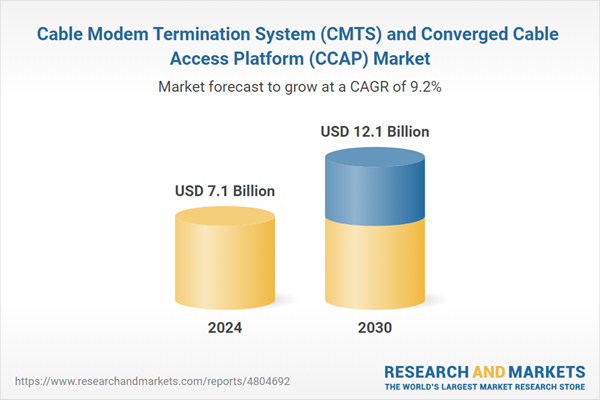The global market for Cable Modem Termination System (CMTS) and Converged Cable Access Platform (CCAP) was valued at US$7.1 Billion in 2024 and is projected to reach US$12.1 Billion by 2030, growing at a CAGR of 9.2% from 2024 to 2030. This comprehensive report provides an in-depth analysis of market trends, drivers, and forecasts, helping you make informed business decisions. The report includes the most recent global tariff developments and how they impact the Cable Modem Termination System (CMTS) and Converged Cable Access Platform (CCAP) market.
Segments: Type (CCAP, CMTS); Standard (DOCSIS 3.1, DOCSIS 3.0 & Below); Application (Consumer, Business).
Geographic Regions/Countries: World; United States; Canada; Japan; China; Europe (France; Germany; Italy; United Kingdom; and Rest of Europe); Asia-Pacific; Rest of World.
The analysts continuously track trade developments worldwide, drawing insights from leading global economists and over 200 industry and policy institutions, including think tanks, trade organizations, and national economic advisory bodies. This intelligence is integrated into forecasting models to provide timely, data-driven analysis of emerging risks and opportunities.
Global Cable Modem Termination System (CMTS) and Converged Cable Access Platform (CCAP) Market - Key Trends and Drivers Summarized
Why Are CMTS and CCAP Pivotal to Cable Broadband?
A Cable Modem Termination System (CMTS) and a Converged Cable Access Platform (CCAP) are essential components in the architecture of cable broadband networks, responsible for managing and distributing internet traffic between service providers and end-users. CMTS functions as the gateway between subscriber cable modems and the service provider's backbone network, facilitating high-speed data transmission over the hybrid fiber-coaxial (HFC) infrastructure. As demand for faster and more reliable broadband continues to surge, CMTS plays a critical role in handling traffic flows, modulating signals, and ensuring efficient data distribution. On the other hand, CCAP is an advanced platform that integrates the functionalities of CMTS and other traditional services like video delivery, voice, and Ethernet, consolidating them into a single, more efficient system. CCAP was developed to address the growing complexity of cable networks as the demand for high-definition video streaming, cloud services, and IoT devices exponentially increases. Together, these technologies are pivotal to the evolution of cable networks, enabling service providers to offer faster, more reliable internet and multimedia services to millions of customers worldwide.How Do CMTS and CCAP Transform Cable Network Performance?
The introduction of CMTS and CCAP has revolutionized the performance and capacity of cable broadband networks, allowing operators to manage the growing data demands of modern households and businesses. In the early days of cable broadband, CMTS alone was responsible for routing internet traffic, a function that became increasingly strained as internet usage grew and video streaming became mainstream. CCAP has addressed this issue by converging multiple services - such as video, data, and voice - into a unified system, significantly enhancing the bandwidth management and operational efficiency of cable networks. One of the primary advantages of CCAP is its ability to scale more efficiently, enabling cable operators to expand their network capacity without the need for massive hardware upgrades. This means that providers can deliver gigabit internet speeds and support high-traffic applications like 4K video streaming, online gaming, and large-scale cloud computing with greater ease. Furthermore, CMTS and CCAP offer enhanced quality of service (QoS) capabilities, allowing operators to prioritize different types of traffic, ensuring seamless service for latency-sensitive applications such as video conferencing and VoIP. As cable operators continue to upgrade their networks to meet the demands of an increasingly digital world, the integration of CMTS and CCAP is proving to be essential in maximizing network performance and ensuring customer satisfaction.What Are the Technological Trends Shaping CMTS and CCAP?
The rapid evolution of cable technology has driven significant advancements in both CMTS and CCAP, enabling them to support the high-speed, high-capacity requirements of modern broadband networks. One of the most impactful trends is the move towards DOCSIS 3.1, the latest version of the Data Over Cable Service Interface Specification. DOCSIS 3.1 is a game-changer, allowing CMTS and CCAP to deliver multi-gigabit internet speeds by utilizing a more efficient method of data transmission over existing cable infrastructure. This has allowed service providers to extend the life of their hybrid fiber-coaxial networks without needing a complete overhaul to fiber, which is far more expensive and time-consuming to implement. Another key trend is virtualization, which involves shifting CMTS and CCAP functionalities to cloud-based platforms, enabling operators to scale services on demand while reducing the need for physical hardware. This transition to software-driven platforms offers greater flexibility, allowing cable operators to deploy new services more quickly and adapt to changing customer needs with ease. Moreover, the rise of Distributed Access Architectures (DAA), where some CMTS and CCAP functions are distributed closer to the edge of the network, is further enhancing network performance by reducing latency and increasing the efficiency of data delivery. These technological advancements are reshaping the cable broadband landscape, enabling service providers to offer faster, more reliable internet services in an increasingly competitive market.What Is Driving the Growth of the CMTS and CCAP Market?
The growth in the CMTS and CCAP market is driven by several factors tied to both technological innovation and shifting consumer behaviors. One of the most significant drivers is the skyrocketing demand for high-speed internet and enhanced multimedia services. As consumers increasingly rely on internet-connected devices, smart homes, and bandwidth-intensive applications such as streaming 4K video and cloud gaming, service providers are under pressure to upgrade their network infrastructures. CMTS and CCAP provide a cost-effective way for cable operators to meet these demands by maximizing the capacity of their existing networks, extending the life of hybrid fiber-coaxial systems, and avoiding the immediate need for full fiber-to-the-home (FTTH) deployments. Another critical growth factor is the ongoing adoption of DOCSIS 3.1 technology, which enables cable operators to deliver gigabit speeds over their legacy networks, making them competitive with fiber and other broadband technologies. Furthermore, the increasing shift towards virtualization in network management is boosting demand for cloud-based CMTS and CCAP solutions, which allow operators to scale their networks more efficiently and reduce the costs associated with maintaining physical hardware. The deployment of Distributed Access Architectures (DAA) is another important factor, as it enhances network performance and enables operators to reduce latency while optimizing data traffic closer to the end user. Finally, the global trend towards smart cities and IoT ecosystems is driving the need for more robust and flexible broadband infrastructures, with CMTS and CCAP serving as the backbone for these digitally connected environments. These factors, combined with a growing consumer appetite for higher internet speeds and improved connectivity, are fueling significant growth in the CMTS and CCAP market.Report Scope
The report analyzes the Cable Modem Termination System (CMTS) and Converged Cable Access Platform (CCAP) market, presented in terms of units. The analysis covers the key segments and geographic regions outlined below.Segments: Type (CCAP, CMTS); Standard (DOCSIS 3.1, DOCSIS 3.0 & Below); Application (Consumer, Business).
Geographic Regions/Countries: World; United States; Canada; Japan; China; Europe (France; Germany; Italy; United Kingdom; and Rest of Europe); Asia-Pacific; Rest of World.
Key Insights:
- Market Growth: Understand the significant growth trajectory of the CCAP segment, which is expected to reach US$9.9 Billion by 2030 with a CAGR of a 11.3%. The CMTS segment is also set to grow at 2.3% CAGR over the analysis period.
- Regional Analysis: Gain insights into the U.S. market, valued at $1.9 Billion in 2024, and China, forecasted to grow at an impressive 8.5% CAGR to reach $1.9 Billion by 2030. Discover growth trends in other key regions, including Japan, Canada, Germany, and the Asia-Pacific.
Why You Should Buy This Report:
- Detailed Market Analysis: Access a thorough analysis of the Global Cable Modem Termination System (CMTS) and Converged Cable Access Platform (CCAP) Market, covering all major geographic regions and market segments.
- Competitive Insights: Get an overview of the competitive landscape, including the market presence of major players across different geographies.
- Future Trends and Drivers: Understand the key trends and drivers shaping the future of the Global Cable Modem Termination System (CMTS) and Converged Cable Access Platform (CCAP) Market.
- Actionable Insights: Benefit from actionable insights that can help you identify new revenue opportunities and make strategic business decisions.
Key Questions Answered:
- How is the Global Cable Modem Termination System (CMTS) and Converged Cable Access Platform (CCAP) Market expected to evolve by 2030?
- What are the main drivers and restraints affecting the market?
- Which market segments will grow the most over the forecast period?
- How will market shares for different regions and segments change by 2030?
- Who are the leading players in the market, and what are their prospects?
Report Features:
- Comprehensive Market Data: Independent analysis of annual sales and market forecasts in US$ Million from 2024 to 2030.
- In-Depth Regional Analysis: Detailed insights into key markets, including the U.S., China, Japan, Canada, Europe, Asia-Pacific, Latin America, Middle East, and Africa.
- Company Profiles: Coverage of players such as ARRIS International plc, Blonder Tongue Laboratories, Inc., Broadcom Ltd., C9 Networks, Casa Systems, Inc. and more.
- Complimentary Updates: Receive free report updates for one year to keep you informed of the latest market developments.
Some of the 47 companies featured in this Cable Modem Termination System (CMTS) and Converged Cable Access Platform (CCAP) market report include:
- ARRIS International plc
- Blonder Tongue Laboratories, Inc.
- Broadcom Ltd.
- C9 Networks
- Casa Systems, Inc.
- Chongqing Jinghong V&T Technology Co., Ltd.
- Cisco Systems, Inc.
- Creonic GmbH
- Genxcomm
- Harmonic Inc.
- Huawei Technologies Co., Ltd.
- Inango Systems Ltd.
- Juniper Networks, Inc.
- NBN Co ltd.
- Nokia Corporation
- Sumavision Technologies Co., Ltd.
- Teleste Corporation
- The Volpe Firm
- Vecima Networks, Inc.
- Versa Technology, Inc.
Tariff Impact Analysis: Key Insights for 2025
Global tariff negotiations across 180+ countries are reshaping supply chains, costs, and competitiveness. This report reflects the latest developments as of April 2025 and incorporates forward-looking insights into the market outlook.The analysts continuously track trade developments worldwide, drawing insights from leading global economists and over 200 industry and policy institutions, including think tanks, trade organizations, and national economic advisory bodies. This intelligence is integrated into forecasting models to provide timely, data-driven analysis of emerging risks and opportunities.
What’s Included in This Edition:
- Tariff-adjusted market forecasts by region and segment
- Analysis of cost and supply chain implications by sourcing and trade exposure
- Strategic insights into geographic shifts
Buyers receive a free July 2025 update with:
- Finalized tariff impacts and new trade agreement effects
- Updated projections reflecting global sourcing and cost shifts
- Expanded country-specific coverage across the industry
Table of Contents
I. METHODOLOGYII. EXECUTIVE SUMMARY2. FOCUS ON SELECT PLAYERSIII. MARKET ANALYSISIV. COMPETITION
1. MARKET OVERVIEW
3. MARKET TRENDS & DRIVERS
4. GLOBAL MARKET PERSPECTIVE
UNITED STATES
CANADA
JAPAN
CHINA
EUROPE
FRANCE
GERMANY
ITALY
UNITED KINGDOM
REST OF EUROPE
ASIA-PACIFIC
REST OF WORLD
Companies Mentioned (Partial List)
A selection of companies mentioned in this report includes, but is not limited to:
- ARRIS International plc
- Blonder Tongue Laboratories, Inc.
- Broadcom Ltd.
- C9 Networks
- Casa Systems, Inc.
- Chongqing Jinghong V&T Technology Co., Ltd.
- Cisco Systems, Inc.
- Creonic GmbH
- Genxcomm
- Harmonic Inc.
- Huawei Technologies Co., Ltd.
- Inango Systems Ltd.
- Juniper Networks, Inc.
- NBN Co ltd.
- Nokia Corporation
- Sumavision Technologies Co., Ltd.
- Teleste Corporation
- The Volpe Firm
- Vecima Networks, Inc.
- Versa Technology, Inc.
Table Information
| Report Attribute | Details |
|---|---|
| No. of Pages | 197 |
| Published | April 2025 |
| Forecast Period | 2024 - 2030 |
| Estimated Market Value ( USD | $ 7.1 Billion |
| Forecasted Market Value ( USD | $ 12.1 Billion |
| Compound Annual Growth Rate | 9.2% |
| Regions Covered | Global |









